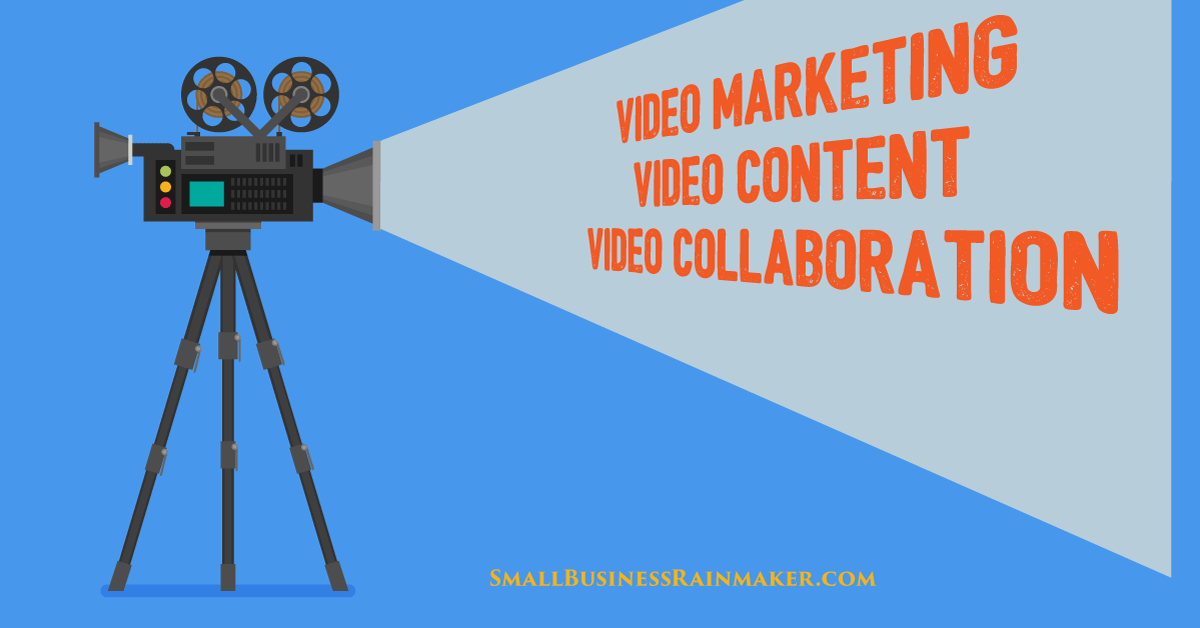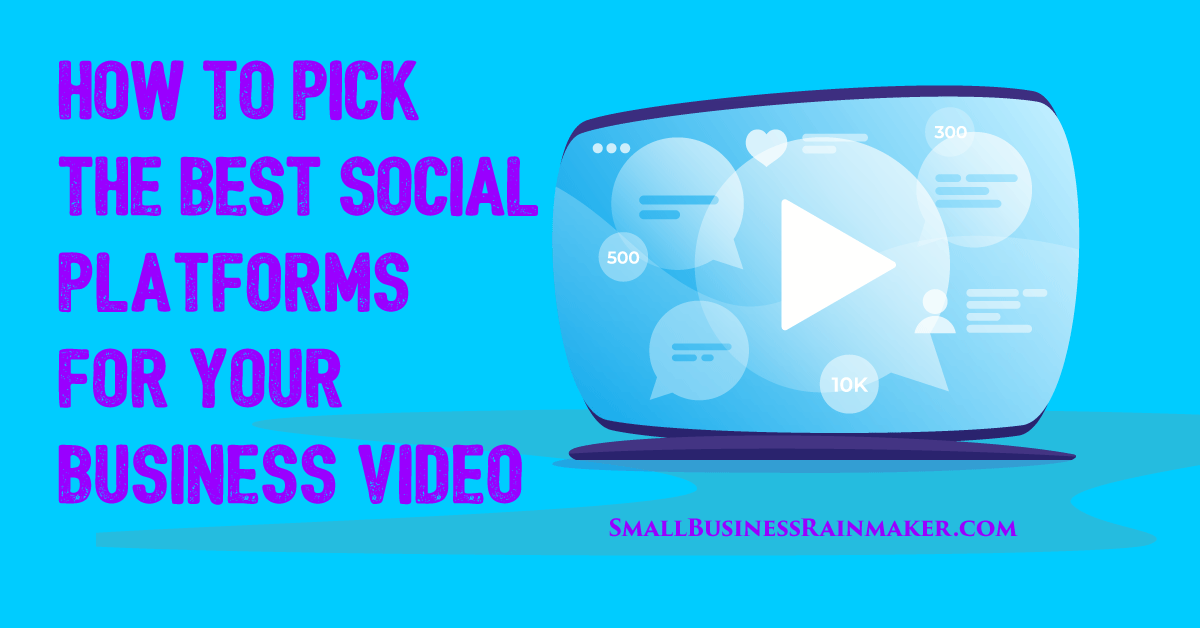
Video is turning up in some unusual ways at small businesses everywhere. I reached out to owners in over thirty industries to learn how they’re using video in their marketing. Turns out they’re using it for a lot more than marketing as we know it.
Aside from video content and video marketing strategies, businesses are using video to collaborate internally with co-workers and externally with both customers and vendors.
The Growing Role of Video Collaboration, Video Content, and Video Marketing in Small Business
Some of the key takeaways from my exchange with these small business video creators include:
- Video is versatile. It can be used across all social media channels and websites and is easy to re-purpose into podcasts, transcripts, blog articles, animated GIFs, and graphics.
- It reduces a company’s workload. Sales, marketing, and customer support all benefit from a reduced workload when they incorporate video. Any department can benefit.
- Production of video content is easier than ever. Anyone can get started with business video. It only takes a smart phone or webcam or screen recorder, a microphone, and some simple planning to start producing your own videos.
- Video works well for internal collaboration and training. Just as video saves time with your interactions with customers, it can do the same for co-workers and vendors.
- Video works in ANY industry or niche.
How You Can Benefit from This Video Strategy Article
I organized their feedback using the first three categories below, according to how their use of video was most compelling, effective, or unusual.
Examples are included. Then we touch on equipment and software.
(While most of the businesses featured below use video in ways that cut across all three categories, it seemed to be a helpful way to organize all this feedback so it was in a digestible format!)
1. How to Use Video Collaboration to Run Your Business More Efficiently
2. Creation and Use of Video Content
3. Video Marketing Strategies and Tips
4. Video Equipment and Software
5. Conclusion
5. Questions About Video Marketing?
We intentionally included responses from a wide range of industries. That’s because, practically without fail, I get the most useful ideas and novel inspiration when I look at how someone is doing something outside my industry.
I urge you to read through them all. Take notes on what strikes you. Ask yourself, “Could I use video like that in my business?”
I promise you’ll find at least one nugget of info or insight that will help your video marketing.
The Foundation for a Business Video Strategy
Another common thread among these successful video creators was that they laid the foundation for their video work in very similar fashion.
They start with purpose.
It begins by answering, “Why do you want to create your video?”
Some of the many possible reasons to use video in your business include: Generate leads, lead magnets, close sales, move people through sales funnel, answer FAQs and reduce customer support inquiries, instruction about products and services, customer education, employee training, employee education, internal collaboration, and collaboration with vendors.
Start with a tightly focused purpose. You can expand your efforts when you get the hang of video production for your company.
They define their viewer.
Equally important as purpose is the notion that you must have a clear picture of your intended viewer.
If your video is intended for customers, use your customer personas to help script and create your video. If it’s for vendors or co-workers, create personas for each viewer to guide your effort.
It’s important to keep in mind that these video tips and tactics are a jumping off point. In other words, an effective video content strategy starts with creating and using video that’s relevant to your viewer.
I did some of the hard work for you because I’m sharing an extensive list of successful real-world video marketing techniques. These tactics are working well today for each of the companies listed. It doesn’t mean you have to incorporate all of these to be successful with video yourself.
Instead, add what you see below to your video ideas list. Then use it as a foundation and source for brainstorming and inspiration.
Use whatever works for your current purpose. Your video techniques will evolve as your experience with video marketing grows.
Let’s start with our first category.
How to Use Video Collaboration to Run Your Business More Efficiently
I’m putting collaboration at the top of the list because I suspect it’s not exactly top-of-mind when business owners are thinking about video. When I hear “video,” my first video thought revolves around marketing and content. We’ll get to those in a minute.
Video collaboration is, however, just as potent a tool for internal work among colleagues and between your vendors and your company. The following three companies are good examples of effective video collaboration.
 Chris Saunders is Founder and President of Integrated Communications, a key player in the Field Mobility ecosystem. And as you’ll see below, Chris is also a career B2B sales expert who leverages video to create sales opportunities and drive business.
Chris Saunders is Founder and President of Integrated Communications, a key player in the Field Mobility ecosystem. And as you’ll see below, Chris is also a career B2B sales expert who leverages video to create sales opportunities and drive business.
It's interesting to note that in reaching out to dozens of business owners for this article about video, I received only one response via video, and it was from Chris.
Saunders and his company have embraced video as an all-encompassing tool for marketing and business development.
They use individually targeted videos in a well-defined B2B market for prospecting, handling objections, proposals, sales call follow-up, thank you videos, birthdays, and more.
Video is so effective that they have a full-time videographer on staff. In addition, they are setting up a video sales company.
Saunder’s top video tips:
1 – Pick a thumbnail that will make people click.
2 – Just do it. People tend to freeze in front of a video camera, but you can quickly get over it. Act like the camera is the person for whom the video is intended.
 Mark Pacitti is the managing director and founder of Woozle Research. They specialize in interviewing thousands of subject matter experts to help investors gain a competitive edge and beat the market.
Mark Pacitti is the managing director and founder of Woozle Research. They specialize in interviewing thousands of subject matter experts to help investors gain a competitive edge and beat the market.
Pacitti’s use of video is also very wide-ranging,
“Institutional investors and financial services professionals in general can be quite stale in how they communicate when compared to other industries such as media and entertainment.
We've seen a huge uplift in staff productivity, client retention, and organic sales growth since we started to use video as a tool for communicating both internally and externally.”
Some examples of how their research firm is using video along with feedback on their results:
Training Videos
“From running payroll to using the latest in-house SaaS software, we have training videos for almost every part of our daily operations. This helps to get new joiners up to speed quickly, allows us to measure staff performance more accurately as everyone gets the same training, and the videos make it easier to explain complicated instructions by visually showing what the person needs to do.”
Video Sales Pitches
“We now can use the same high-quality, well-scripted piece of video content to share with prospective clients and we know:
a) they can look at it whenever they want;
b) they can re-watch and share it; and
c) they will all receive the same high-quality content every time!
It's worked wonders with client sales growth, and it's saved me so much time it's quite incredible! People also want to self-serve nowadays and they don't want to be talked at by a salesperson!”
Video Research Updates
Woozle used to send written research reports. Now an equity analyst will do a short video summary.
Says Pacitti, “We've found most people prefer to watch the video rather than reading the article even though the subject matter of our content is fairly complex in terms of providing investment professionals with buy or sell recommendations on publicly listed companies!”
Pacitti’s top video tips:
“Make videos concise and to the point. Focus on one main topic/message per video and then bucket them together into bigger topics…
Also, little and often is key because it means you can build up a huge library over time and you can always re-record a short two-minute video if it's not clear or not being watched…”
 Joe Martin is VP of Marketing and Strategy at CloudApp, a video-led solution for enterprise collaboration. In a decidedly non-traditional manner, Martin and CloudApp created a video-led social media campaign to publicize their latest seed-funding round in which they raised $4.3 million.
Joe Martin is VP of Marketing and Strategy at CloudApp, a video-led solution for enterprise collaboration. In a decidedly non-traditional manner, Martin and CloudApp created a video-led social media campaign to publicize their latest seed-funding round in which they raised $4.3 million.
The conventional method is to use a PR agency to get coverage in a top-tier media outlet. Their video campaign added significantly to the coverage they got from the agency.
“With these videos we used the relationships we had with both customers and influencers to extend the value of the announcement with video for under $500. The videos had north of 50k views, thousands of social engagements, and helped increase our web volume by over 2x that week. This is just the beginning though as the stats show that people want video all around.”
Regarding collaboration, Martin says,
“Customer support persons using CloudApp have shown to close tickets 3x faster with video, shareable GIFs, and screenshots.
Customers don't want long, drawn-out live chats, they want a quick answer and they want it visually. It’s also a more personalized way to connect with customers from a sales position or remotely with your team.”
“Globally, 70% of professionals work remotely more than one day a week, while 53% work remotely for at least half of the week. The working world is rapidly changing, and video will be at the forefront of collaboration and connection.
That is why companies like Zoom and Slack have found so much success. Using video between colleagues can be a great way to quickly resolve issues, solve bugs, reduce meetings, create quicker onboarding, and be more personal. It can help create the illusion of an office without a physical space.”
Martin’s video marketing tip:
“Video can also provide a great way to extend a piece of other content. At CloudApp we have recently started adding video briefs to our blog posts. In a fast moving mobile world, a quick video can provide a way for someone to sample the post with their AirPods and screen before they choose to dive into a meaty 2,000 word post.”
Creation and Use of Video Content
The term “video content” covers a lot of territory. Video is primarily used as an inbound marketing tool to help attract the right kind of leads for any given business.
I set it apart as a category to illustrate that businesses in any niche can do this.
For example, the business owners who responded come from a wide range of industries:
- health and wellness
- marketing
- career coaching
- business coaching
- web development
- contractor (concrete)
- market research
- parking
- advertising
- real estate investing
- insurance
- mattresses
- inventory management
- business finance
- product review sites
- gaming
Whatever your business niche, there is indeed a way for you to use video.
Here’s how several of these companies are creating video for inbound marketing campaigns (and more).
Alexandra Tran is a wellness and lifestyle blogger at schimiggy.com, as well as a yoga and meditation instructor.
 Tran only started posting videos on YouTube in the last ten months. In that short time, 12% of blog visitors now come from YouTube and here visitors increased 29%, rising from 35,000 to 45,000 per month. She notes that videos attract a different demographic—auditory learners—that she wouldn’t otherwise get.
Tran only started posting videos on YouTube in the last ten months. In that short time, 12% of blog visitors now come from YouTube and here visitors increased 29%, rising from 35,000 to 45,000 per month. She notes that videos attract a different demographic—auditory learners—that she wouldn’t otherwise get.
“The videos I am creating are review videos. People want to know how something fits and works and that's what my YouTube videos show.
I also have written reviews of the same videos with more detail on my blog.”
Tran’s video tip:
"I recommend having the appropriate equipment. Definitely use an iPod and use stock images and music to make your videos sound professional! Also, practice what you're going to say beforehand. I tend to say “uhh” and “umm” a lot in my videos and I hope to change that as I improve...”
 Anastasia Iliou is the Senior Content Manager for MedicarePlanFinder.com, an educational resource for Medicare-eligible people and their families.
Anastasia Iliou is the Senior Content Manager for MedicarePlanFinder.com, an educational resource for Medicare-eligible people and their families.
“We produce a combination of GIFs and brief (no longer than one minute) live videos with fun facts.
People tend to scroll right past written posts in their news feeds, but videos get their attention.
We created GIFs by taking stock videos of seniors (our main target market) and editing them to add our branding (colors, logo, etc.). They are much more attention-grabbing than still images.”
Iliou’s video strategy tip:
Use your blog’s SEO to get people to the page. Then use video to keep them there longer.
 Brett Ellis is a career coach and personal branding speaker at Career Marketing Services.
Brett Ellis is a career coach and personal branding speaker at Career Marketing Services.
“I have seen some great success with my videos through Instagram. I don't do much video, but my Tip Tuesday videos work really well for me in generating business.
I don't really do any cold calling type of sales at all. I focus specifically on creating consistent and valuable content and clients usually reach out to me.
I create quick, 1-minute video tips on Instagram around the topics of career development and personal branding (resumes, cover letters, LinkedIn, getting featured in articles, etc.).”
Ellis’ top tips:
Always provide value. Consistently providing great information keeps him top of mind and generates numerous referrals.
Use sub-titles to increase engagement.
 Iryna Shevchenko is a Facebook group expert who advises online coaches how to use Facebook groups to grow their business.
Iryna Shevchenko is a Facebook group expert who advises online coaches how to use Facebook groups to grow their business.
Shevchenko believes in creating as many videos as possible, tailored to your target audiences.
“For example, when you talk to the cold target, I would do how-to and educational (or inspirational) videos. If your goal is to grow your list, add a CTA (Call-To-Action) to those videos.
The next level of videos would be FAQs. Videos build a trust with your audience twice as fast as any other written content. That is why you can start building a relationship with providing value through the videos and when your audience is fully in love with you and what you offer you can introduce your product and service through the videos and get real results.”
Shevchenko uses video on social media to attract new followers and prospects. She then uses email (with video) to quickly build a strong relationship.
While her specialty is Facebook, Shevchenko recommends using any and all social channels where your customers can be found.
Shevchenko’s best video tips:
Overcome your fear about using video. Video is too powerful a tool to ignore. “The moment I overcame my inner fears related to being on the camera, I skyrocketed my business.”
Create a video schedule to release a 1-2 minute video at least once a week.
 Derrick Rehn is an SEO specialist at Integritive, a web development company with plenty of video marketing experience.
Derrick Rehn is an SEO specialist at Integritive, a web development company with plenty of video marketing experience.
They created a series of videos for their clients and prospects on how to use WordPress.
“Our videos help us to keep customers informed, educated, and up to date on industry trends. This leads to less customer support inquiries and makes it easier for our customers to find the answers they need.”
Rehn also finds that video is great at increasing conversion rates. They’ve had their highest success with YouTube videos.
Rehn’s top video suggestion:
“Make the videos informative & to the point. No one wants to watch a 6-minute video that features excessive opening graphics and rambling content.
Break things up into straightforward and easy-to-understand content.”
 Earl Choate is the CEO of Concrete Camouflage, a company that manufactures and sells concrete staining supplies.
Earl Choate is the CEO of Concrete Camouflage, a company that manufactures and sells concrete staining supplies.
“One marketing strategy that has increased brand awareness for our company has been publishing online videos on YouTube.
We embed the videos in some of our blog posts.
Rather than a traditional blog article, we make information tutorial videos that show our customers how to use our products and how to troubleshoot roadblocks they may face in their home projects.
Videos provide important details that can't often be captured in written text format. Its been an inexpensive way to connect with customers and has also reduced the amount of time spent on customer service. We now receive fewer customer phone calls because many are able to find answers to their questions in our videos.”
Their company also has a sense of humor, as you can see in this homepage introductory video.
 Emily Carroll is Marketing Coordinator for Drive Research, a market research company.
Emily Carroll is Marketing Coordinator for Drive Research, a market research company.
“Our approach is capturing how-to or “X tips for Y” videos in a minute or less. We call this video series, 0-60 with Drive Research.
It is shot very simply with a computer, a video conferencing camera, and a member of our team speaking to a certain market research topic. We then take the footage and edit it together with a free online video maker, ClipChamp.”
Videos are then shared on their YouTube channel, then their blog, as well as on social media such as LinkedIn and Facebook.
Their results?
“When we post a video on LinkedIn it performs 5X to 10X better than that of a static image. To put this in perspective, a static image on LinkedIn will serve anywhere from 50-100 impressions max. Our videos, on the other hand, will start with 500 impressions and grow to 1,000 within a month of being on LinkedIn. Videos are also more likely to be shared by our followers than any other type of content.”
Carroll’s top tips for video creation:
Keep the videos to one minute or so. Everyone has a minute to spare.
“If you wish to publish longer videos, include timestamps in the description of the video so users know exactly where to start your video to get the information they're seeking. It's all about making videos easily digestible for the user!”
 Gregory Golinski is Head of Digital Marketing for YourParkingSpace.co.uk, a site that helps motorists find and book parking spaces online.
Gregory Golinski is Head of Digital Marketing for YourParkingSpace.co.uk, a site that helps motorists find and book parking spaces online.
Golinkski’s tip is simple.
"Use good old fashioned animated GIFs once in a while on your social media channels, particularly Facebook.
There's something addictive about animated GIFs.
They catch people's attention, and the way they capture a funny, crazy moment in time is fascinating.

I believe a quality animated GIF can be more striking and powerful than a classic video for marketing purposes. GIFs attract lots of likes and interactions on social media…”
 Hilary Russo is a certified Integrative Nutrition Health Coach and Havening Techniques® practitioner. She’s also an award-winning journalist, host, college professor.
Hilary Russo is a certified Integrative Nutrition Health Coach and Havening Techniques® practitioner. She’s also an award-winning journalist, host, college professor.
“As a certified holistic health coach, I wanted to do something to reach out to people to give back as I build my business. So, I started doing a weekly video series on Instagram a year ago to increase awareness about holistic health with my weekly series Kitchen Cabinet Confidential.
Each week I share a one minute video of an item in your kitchen that you are told are healthy but are never explained why. That's where I come in.
By staying constant with my branding, I've not only authentically (key word) increased visibility and clientele and offered a takeaway, I've found the proper branding has given me the edge to partner with media outlets as well as health based companies.
It's on my website, But I mainly use Instagram, Facebook, Twitter mainly as of now for social media. I'm redesigning my YouTube as well as incorporating it into future blogs.”
Russo’s top video tip:
“Be yourself. Talk to one person. I call that the “audience of one.” This is connection.
If videos are new to you and all you see is a camera lens, put a smiley face on a sticky note or a pic of someone you find it easy to talk to and just share. Don’t talk TO that person. Have a conversation with them and show your personality.”
 Kean Graham is the CEO of MonetizeMore, an 8-figure ad tech company with 100+ employees around the globe.
Kean Graham is the CEO of MonetizeMore, an 8-figure ad tech company with 100+ employees around the globe.
“We built a highly engaged YouTube channel in a very niche industry.
This YouTube channel brings in consistent high quality leads and has boosted our brand for the below reasons:
- We hired an actress in Hollywood to do the intros and voice-overs.
- Each video goes over solutions to problems our target audience has in a step-by-step screen-cast.
- We provide CTAs at the end of the video that are relevant to the video content.
YouTube has improved our branding the most and has the best conversion rates. We post new videos every 2 weeks. We have about 3,000 subscribers now in a very niche industry and have driven some high profile leads as a result.”
Graham’s best video tips:
“1. Post for Reach:
Make sure to not only post on YouTube but also Facebook, Vimeo, Daily Motion, etc. You can use TubeMogul to streamline the posting. Don’t forget to post on your own site as well!
2. User Attribution:
Make sure to use Google UTM links to tag each link so that you know exactly where each lead came from, so you know which lead sources are the most successful. Then you’ll know which platforms to leverage more as you iterate your video campaign.
3. Analytics:
It’s important to track the videos on your site even closer. Especially your conversion videos! You can implement Google Analytic events to determine where video users are dropping off to further optimize the length and content of the video. This is key to improve the performance of your sales funnel.”
 Matt York is a real estate investor in Cincinnati, Ohio.
Matt York is a real estate investor in Cincinnati, Ohio.
"...Nothing catches an audience’s eye like a video. A picture says a thousand words, but do you want your audience to filter through a thousand words?
With video, you can create credibility all-while telling your audience exactly what they need to hear. When they see a video, with a real human talking on screen, this creates trust for the company.
Once you tell them what they are wanting to hear, they feel more comfortable reaching out, or at least studying your company a bit further.”
York uses videos on Facebook and YouTube. He also finds it helps conversions on his website.
 Matthew Claassen is CEO of Medigap Seminars Insurance Agency and claims to be one of the most successful video marketers in his business niche, Medicare insurance.
Matthew Claassen is CEO of Medigap Seminars Insurance Agency and claims to be one of the most successful video marketers in his business niche, Medicare insurance.
And he can back up his claim. I just visited YouTube and typed “Medicare” in the search bar and three of Claassen’s videos popped up on page one. He typically gets 1,000 views of his videos per day.
Many of the 10,000 people turning 65 every day need to enroll in Medicare. It’s a complicated, confusing subject.
“Most of my competitors chase after people turning 65 by telemarketing and direct mail. So much so that many people turning 65 end up turning off their phones or investing in anti-spam telephone devices and piling junk mail almost waist high.”
Claassen takes an inbound approach by placing his videos where seniors are going to research—the internet. He places video content on YouTube and his website.
“I produced multiple educational videos, almost 40 so far. Each are designed to educate, not sell. I breakdown a complicated subject and help seniors make an informed decision. (My company slogan.)
For the consumer, they get the help they need in order to feel confident in their decisions regarding Medicare. For me and my company these videos have been a tremendous source of new business.
When people reach out to me after watching my videos, they already see me as a person who is knowledgeable, trustworthy, willing and capable of helping them. It's not uncommon for people to call me after watching my videos and simply ask me to help them. They want to work with me and my company because of what they see in the videos.
As a result, my insurance agency now helps seniors in all but two states, from Hawaii to Virginia and Alaska down to the Florida Keys.”
Claassen’s top video production tips:
As we’ve heard from others, a key tip is to “be yourself.”
“You do not need to pretend to be excited, speak fast or use exaggerated hand and facial motions. People want to watch a real person.
Don't use a video for a sales pitch. Use the video to gain credibility and show you are knowledgeable in your field.
Use the video so that the viewers like and trust you once they have finished watching.
Of course, make sure they know how to contact you. A good percentage of viewers will do just that and will want to do business with you. Then, above all, always do what is in the best interest of your client.”
 Matthew Ross is co-owner and COO of one of the leading sleep and mattress review websites, Slumber Yard.
Matthew Ross is co-owner and COO of one of the leading sleep and mattress review websites, Slumber Yard.
“My business partner and I truly believe video is the future of internet content and consumption. In fact, we've structured our entire content strategy around video.
Not only do we pay for video advertising, but we also create video content ourselves. To cut to the chase, we create helpful YouTube videos in-house to attract viewers and (hopefully) turn them into customers.”
Ross has found that by creating content videos relevant to their audience, they often rank on the first page organically instead of relying on paid ads. To date, Slumber Yard’s YouTube channel has over 115 million views with more than 23,000 subscribers.
“All in all, creating YouTube content is a lot more cost efficient than strategies like PPC ads or traditional print marketing. In other words, you can get in front of potential customers that are searching for related services or products for a very low cost. Last year, our in-house video content attracted over 1.6 million views for a fraction of what other marketing strategies would have cost.”
 Chinh Nguyen is Co-founder & VP of Marketing for Finale Inventory, a cloud-based inventory management system that handles all stock movements from purchasing through to sales. He’s responsible for the company’s inbound marketing programs.
Chinh Nguyen is Co-founder & VP of Marketing for Finale Inventory, a cloud-based inventory management system that handles all stock movements from purchasing through to sales. He’s responsible for the company’s inbound marketing programs.
“We have found that incorporating videos has really helped us share our company's culture with both customers and future employees. Many studies have shown that millennials tend to be more loyal towards brands that appeal to them on an emotional level.
Sometimes it’s necessary to look at how your company comes across. Is it spontaneous, friendly, and engaging? Using videos has helped to give our business personality.”
Their website includes a video FAQ page with an incredible 97 videos explaining everything you might want to know about how their inventory management software works. They used a screen recording software with voice narration.
A smart SEO move that helps Google search results is that each video page also includes a transcript. While YouTube videos are partly ranked according to the narrative content (transcript), Google doesn’t have that capability—at least not yet. So a written transcript gives it text-based SEO juice on Google.
 Octavia Conner is the CEO of Say Yes to Profits, a virtual CFO business that helps six and seven-figure businesses gain financial clarity and control to increase cash flow, boost profit margins and accelerate business growth.
Octavia Conner is the CEO of Say Yes to Profits, a virtual CFO business that helps six and seven-figure businesses gain financial clarity and control to increase cash flow, boost profit margins and accelerate business growth.
“I use video marketing to find potential clients for my virtual accounting firm.
Located on my YouTube channel, I create how-to videos regarding QuickBooks, cash flow acceleration, reducing business taxes, profit maximizing and business building.
After uploading my videos to YouTube, I then embed them on my website and post them on my social media platforms, such as LinkedIn, Facebook, and Instagram.”
Video marketing is one of the main ways Conner attracts clients from around the United States.
 Sadi Khan is the Content Marketing Manager at RunRepeat, an athletic shoe review site.
Sadi Khan is the Content Marketing Manager at RunRepeat, an athletic shoe review site.
“We recently added videos to our marketing mix, simply because YouTube is the second most visited website after Google. More than 1 billion hours of YouTube videos are watched every day.
We are producing expert running shoe reviews and running tips videos for YouTube.
It's still early days but we can see a great engagement rate and brand awareness resulting from these videos.”
 Shawn Breyer is Owner of Breyer Home Buyers, a real estate company based in Atlanta.
Shawn Breyer is Owner of Breyer Home Buyers, a real estate company based in Atlanta.
“We do daily Facebook live videos on topics that help people in our niche. These are typically how-to videos since they add the most value to the audience. Our goal is to put out a ton of helpful and actionable content that builds goodwill with our audience.
With each Live video, we casually make an offer that if they want to work with our company, then head over to our website and fill out the form on the site.
When people land on our site, the traffic is warmer. Since they have an idea of what to expect from our company, they don't just bounce right off.
A decrease in bounce rates and people spending more time on our site tells Google that our site is relevant to the audience landing it. This has improved our rankings for our site, allowing us to rank in the top three spots for most of the keywords that we are targeting.”
 Stacy Caprio is Founder of Growth Marketing and Colorful Eyes.
Stacy Caprio is Founder of Growth Marketing and Colorful Eyes.
“For my color contact website, I've achieved success through video content marketing, receiving over 500K purely organic views on a single product-based video, with much of that traffic converting into site traffic and sales.
My strategy was to create the most useful color contact video out there, with good lighting and no filler moments or fluff.”
Like many solopreneurs and owners of smaller businesses, Caprio was reluctant to take the plunge into video.
"It took me forever to get the courage to take the first video because I kept putting it off telling myself I didn't have enough time, when really the only thing I was lacking was motivation."
 Will Hankinson is a software developer and entrepreneur with experience in video games, startups, and digital agencies with multiple Fortune 500 clients.
Will Hankinson is a software developer and entrepreneur with experience in video games, startups, and digital agencies with multiple Fortune 500 clients.
“I have three professional personalities right now: digital agency, indie game developer, intro maker. Through each of these lenses, I'm seeing slightly different approaches to video.
At an agency level, the company I work for is pushing the idea that companies need to become brands that can push a story across social, web, and advertising.
They're shooting traditional ads with big budgets and doing what I would consider the most classic type of video advertising.
In the indie game world, GIFs and Twitter are king. With video games, it's all about building pre-launch hype.
Flashy GIFs that can go viral on Twitter will do more than any highly produced trailer could do. This has led to a trend of working in the open more, where developers post a ton of in-progress work.
There are two positive outcomes for indie developers here. The first is that you're seen by publishers to have enough interest/traction to warrant a publishing deal. The second is that things that get retweeted a lot within the industry community on Twitter often find their way to the gaming subreddits, which is where the majority of our customers actually congregate.
My final insight into video in 2019 is through a website I operate, IntroCave Intro Maker. When I took over the site last year, I assumed it was mostly going to be used by budding YouTube stars who wanted to make a serious go at starting their own YouTube channel--and primarily gaming channels judging by the types of intro videos the site sells.
I've been pleasantly surprised by the number of small businesses (gyms especially) that see having an active YouTube channel as an important marketing channel.”
Video Marketing Strategies and Tips
The following businesses base their strategic video marketing on various beliefs about what’s going to happen with video in the coming months and years.
 Brandon Fargo is the CEO and Owner of Brahvia Consulting a performance marketing agency that helps brands scale with Facebook ads and paid media. They use video for themselves and their clients.
Brandon Fargo is the CEO and Owner of Brahvia Consulting a performance marketing agency that helps brands scale with Facebook ads and paid media. They use video for themselves and their clients.
“Our agency is highly focused around video and specifically video content. We utilize it not only in our agency but for our clients as well. It is the principal factor in all our marketing strategies. We create everything from how to videos, promotional videos like video sales letters or just content.
We focus all of this video on social media. It is less expensive for us to get someone to watch a video on Facebook, let's say, then it is to actually drive traffic to a website and get them to consume the same video.
Over the next couple years, you will see a huge shift in marketing metrics. Click through rates will become irrelevant as more and more people stay on social platforms and don’t leave.
Facebook and Instagram by far give us the best results. There are billions of eyes on these two platforms and Facebook is making a huge push for relevance and video content specifically. We find this extremely helpful to us and are being rewarded for it. Using video, you will notice much lower ad costs and much higher ROI.
The biggest return by using video is being able to connect with your audience in a unique way. That really is where we are right now, in an age where consumers want to connect with the brands they buy from and will ONLY buy from brands they truly connect with. Video allows anyone and any size business get in front of their audience and connect with them in ways no website or image could.”
Fargo’s primary video tip:
“Just do it and do it consistently. Don’t worry about high production. If you are on a low budget, anyone with an iPhone can record a video now. Just get out there and start speaking to your audience; the rest will fall in place.”
 Anthony Gaenzle is Owner at anthonygaenzle.com and Director of Marketing at SE Healthcare, a software solutions provider for healthcare organizations.
Anthony Gaenzle is Owner at anthonygaenzle.com and Director of Marketing at SE Healthcare, a software solutions provider for healthcare organizations.
He uses video according to where the prospect is in their buyer journey.
“One type of video that we’ve found to be really useful as a software company is a pre-recorded demo video.
We use a mix of animation and screen capture of the actual tool, but for small businesses on a budget, a program like Camtasia can create a demo of a product, a walkthrough of a website or any number of things fairly affordably.
A video like this takes the burden off of a sales team and saves them the time they’d have to spend with hour-long in-person demos.
Earlier in the buyer journey, we use thought leadership pieces, adding value for the prospective client. These pull in viewers with free advice and expert insights and help to build a relationship. Viewers make a connection with the brand, and then the goal is to grab their interest with info about products we offer that can help provide solutions to the problems they face.
These types of videos can be a really valuable tool to help gain that initial interaction with the brand and start the conversation, but the thought leadership and value-added video and other content should continue long after the sale is made to help maintain the relationship and retain the client’s business.”
 Vivek Kumar is the CEO of Qlicket, a company dedicated to reducing employee turnover.
Vivek Kumar is the CEO of Qlicket, a company dedicated to reducing employee turnover.
“As a software-as-a-service (SaaS) startup, the concept behind our business can be difficult to explain in written form.
We decided to commission a one-minute explainer video that we use to succinctly explain our business to potential customers and investors.
We use this video in many capacities. In addition to playing the video during investor pitches and customer demos, we include a link to the video in nurturing efforts such as our email newsletter.
Through nurturing, we can use the video as a mechanism in our customer funnel, boosting awareness and contact with our company. Video marketing, if done correctly, can be inexpensive and highly effective.”
 Akos Gabossy is CEO and Co-founder of the PanIQ Escape Room Franchise.
Akos Gabossy is CEO and Co-founder of the PanIQ Escape Room Franchise.
PanIQ customers expect to step into a different world when they visit the escape rooms. To create the feeling of being there, Gabossy and his video team create professional Hollywood-style movie trailers for each theme. They use actors and the video is shot inside the actual game rooms, so customers get to sense the immersive set design of the escape room.
Says Gabossy, “For April's Fool, for example, we created a campaign with a real-life llama. (Yes, we actually brought a llama inside our Prison room in Budapest.)
[video example below - Can You Save the Llama?]
The organic reach of the campaign was insane, the combined number of views of the video on Facebook was more than 200,000.”
Gabossy uses videos on their website along with shorter 15 second versions on Instagram, YouTube, and Facebook.
He credits the engaging videos for a low bounce rate and high time-on-site. In other words, people come and stay longer to visit multiple pages. They outsource the video work to a video team from Hungary that handles actors, costumes, and technology.
Gabossy’s top video tips:
The first 1-3 seconds are the most important part of every commercial video that is designed to be used online.
Nobody cares about you or your product. You have to sell emotions and solve a problem through the visual content.”
 Jammie Jelks is Founder and CEO of JelksMBA, a provider of lending services to individuals and families across the United States.
Jammie Jelks is Founder and CEO of JelksMBA, a provider of lending services to individuals and families across the United States.
"Video marketing is a HUGE part of what we do.
My company is using video and digital marketing to meet consumers where they are, online.
Our videos are lead magnets that are advertised on social media. Our social media ads drive traffic to our landing pages where consumers have the opportunity to learn more, schedule a call, and/or apply for financing. Facebook Ads continue to be a big focus for us.”
 Kent Lewis is President & Founder of Anvil Media which specializes in analytics, search engine and social media marketing services. He’s also been writing and speaking about video marketing for over six years.
Kent Lewis is President & Founder of Anvil Media which specializes in analytics, search engine and social media marketing services. He’s also been writing and speaking about video marketing for over six years.
“Video matters because it is the most engaging media format available, online or offline. It's a multi-sensory experience that increases engagement by 5x over the written word. Facts tell, stories sell, and nothing sells better than video.
We've tested a variety of video types: customer testimonials, educational videos and even an infomercial.
The benefit of embedding YouTube videos is that you get the value of the visibility on YouTube and Google video search but also have the creative control of the content residing on your own website.
Our primary objectives with video are general awareness (which is somewhat effective), thought leadership (for which it is more effective) and engagement (for which it is most effective).”
Lewis’ top video tips:
"My number one tip for marketers looking to get the most from video (primarily via email and social media channels) is to recycle!
A single 2 minute HD video can be turned into articles and blog posts (via transcribed text), still images (for Pinterest, Instagram and other platforms), audio (for podcasting) and of course multiple form factors in video (ideally a 30 second version on Instagram, 1 minute native video on Facebook and 2 minutes on YouTube).
Syndication is a powerful tool indeed. The beauty of video is that it can be very affordable to create (smartphones have HD cameras), editing software can be free or affordable, thus making the ROI compelling.”
 Brittany Morales the owner of Brimagraphics LLC.
Brittany Morales the owner of Brimagraphics LLC.
Morales finds video ads to be the top way to attract new clients.
“I find that video is more engaging, and it allows for people to feel like they get to know you because they can hear your voice and see you as you’re speaking. So, it’s a lot more personal than just a picture ad.”
By utilizing how-to and inspirational videos, Morales has increase her following and continues to generate more leads.
 Lorrie Thomas Ross is owner of Web Marketing Therapy, Inc., which specializes in digital marketing optimization.
Lorrie Thomas Ross is owner of Web Marketing Therapy, Inc., which specializes in digital marketing optimization.
“I am a small business owner who invested in an overview video to better explain the uniqueness of my business. Instead of a bunch of videos, I hired a super quality video company and have an asset that I use on my website and social media.
I also use Facebook live for more real videos and help my clients use video as part of their marketing puzzle as well.
My company does not do video. We help SBOs hire the right companies or do the video creation on their own.”
 Lucy Rendler-Kaplan is Founder of Arkay Marketing & PR, a boutique public relations agency specializing in a variety of products & services in the worlds of CPG, beauty, cuisine, kids, music, health, and fitness.
Lucy Rendler-Kaplan is Founder of Arkay Marketing & PR, a boutique public relations agency specializing in a variety of products & services in the worlds of CPG, beauty, cuisine, kids, music, health, and fitness.
Rendler-Kaplan is a proponent of video and Facebook Live in particular.
“The cool thing about a Facebook Live video is that once you have taped it, the video stays on your company’s page (or your own profile). That means that people who might have missed you live will still get to see you show up on people’s feeds well after you’ve gone live.
You already know that posts with likes, comments and shares are prioritized on the news feed. And because of Facebook’s ever changing algorithms, live videos streaming in real-time are now getting ranked even higher, so even more people are seeing them.
In fact, according to Adweek, Facebook Live videos receive 5x more engagement than standard photo posts!
Keeping this in mind, try to get viewers to interact during your live stream. This not only keeps audiences engaged, but it almost ensures you will get more views.
While you are live, ask questions of your audience and then tell viewers to reply in the comments. You can even add an incentive by running a live contest during your broadcast – ask viewers to like, share, and comment on the post and then they can be entered into a free giveaway raffle, for example.”
Rendler-Kaplan’s Video Tip – How Should I Use Facebook Live?
There are an infinite number of ways Facebook Live can fit into your marketing strategy. Just make sure that you HAVE a strategy and know WHY you are going live.
Here are our favorite ways to add Facebook Live to your planning:
1. Answer Questions
A great way to utilize Facebook Live is to answer questions in real-time. An easy way to do this is to gather a few questions people regularly ask when commenting on posts or writing to your website. You have to think – if even one person has a certain question, perhaps others do as well!
2. Show Off an Event
Smart marketers know that creating FOMO (sorry, not a huge fan of the term, but it’s relevant here) creates interest. You can stream live from an event you are hosting and if you do it well, you will create new customers that won’t want to miss your next event!
3. Invite People In
These days, people want more than a great product. They want a great product FROM a great brand.
But how do you really know what’s hiding behind a logo? Facebook Live gives you the perfect opportunity to introduce the people that make up your company. You can do quick interviews with employees in various departments, show off your office space, or give a sneak peek into a meeting or event.
When people get a glimpse into your company culture, it can help with finding new hires, followers and even brand advocates who want to be a part of what you’re showing off!”
 Philip Robinson is Marketing Director for multi-national B2B cybersecurity company Lepide, which helps organizations analyze user behavior and secure sensitive data.
Philip Robinson is Marketing Director for multi-national B2B cybersecurity company Lepide, which helps organizations analyze user behavior and secure sensitive data.
“We thought long and hard about how to utilize video in our marketing strategy beyond the normal product videos, and we have developed a strategy that works well for us.
We decided that the best way to get people talking about the problems we solved is to act as though we were a media company and not a vendor.
We created a weekly podcast known as CISO Talks, in which we discuss cybersecurity issues relevant to our target audience with known influencers in the industry. We have had some success (and fun) recording these shows and releasing them weekly as 10-minute episodes hosted on YouTube, Soundcloud, iTunes, and Spotify. The videos are entirely educational, and our branding is shown throughout to help raise awareness and associate our brand with the solution.
However, the majority of our success using videos has been on social media, particularly LinkedIn and Facebook.
On these platforms we chop up each episode into bite-sized chunks (usually one or two minutes long) that focus on a single talking point and share them on a daily basis. Our objective here is to start a conversation and encourage the influencers featured on the episode to share the posts to their audience (which they regularly do).
The results have been significant.
Our social media following has almost doubled within four months and our post reach and engagement have improved dramatically. Creating this show has been the easiest way to engage influencers without having to pay them any money to appear.
On multiple occasions, when our sales team get into deals, the CISOs are already aware of who we are because of our social media activity and we have developed trust with them by being associated with influencers.”
 Richard Williamson is Vice President of Marketing at HealthLynked.
Richard Williamson is Vice President of Marketing at HealthLynked.
“We are a small tech startup in the medical field with a product line that tends to be extremely hard to grasp. We use two short, simple, animated videos to explain the product. They work VERY well.
The real advantage is the animation. We aren't bound to what you can do with live people, so we can use symbols to tie concepts together.
For example, we offer a cloud-based software that allows people to store and share their health records and carry them anywhere they go. We have an animated cloud that hovers over the characters--sometimes one, sometimes a family--and it appears wherever they go. It's very effective.
We also use a short video to describe the setup process for a WiFi hub we market. Buyers don't get how to set it up, even though it's not that difficult. We would get calls and emails about the setup every day. Now, we link the video in a welcome email, and our calls for how to set up have dropped to nothing.
In a past position, I used videos to explain complicated robotics systems. Conceptually, what we made and sold was pretty simple, but once you saw it in action, it was even more impressive and understandable.
Our next plan is to introduce videos into our social media.”
 Roberta Perry is co-founder and owner of ScrubzBody Skin Care Products.
Roberta Perry is co-founder and owner of ScrubzBody Skin Care Products.
"I love videos for my customers because it shows the "me" behind my brand.
I do monthly live videos using either my iPhone or with QuickTime on my computer. I pre-record weekly tips about skin care, how-to tips, customer service, etc., about 2-3 at a time, and post them both on Facebook. Then I post to YouTube. Then I post from there onto every social media platform I use.
It is a great way to get content that is not only relevant, but personal, out to my customers and potential customers."
Perry’s video tip:
“I think just speaking naturally, like you are speaking to a friend right in front of you, is the best way to feel comfortable. And be prepared. That is 90% of the battle.”
 Syed Irfan Ajmal is serial entrepreneur, digital marketer, columnist, international speaker and Founder of SIA Enterprises.
Syed Irfan Ajmal is serial entrepreneur, digital marketer, columnist, international speaker and Founder of SIA Enterprises.
“We use videos in 2 ways at our marketing agency:
1. Recording any workshops or speaking gigs that we do.
2. Converting our audio podcast show into a video one using animations and also recording video tutorials (e.g. webinars).
Once the video is created, we post the full version on YouTube as YouTube is where people want to watch long-form content (and our videos are typically 1 hour long).
From time to time we create short 30 second highlights of some of these videos too and post them on Facebook, Twitter, and LinkedIn to drive traffic to the main/long video that's on YouTube.”
Ajmal’s top two video tips:
1 – Add captions to all your Facebook videos. One study found that most people watching Facebook videos do so with the audio muted.
2 – “Add the embedded video on your website, and under that put the transcribed version of it in text format. This is because Google isn't able to process audio/video content yet, and adding the transcription helps you get ranked higher in search results. Plus, a one hour video should result in about 7000-10000 words and long-form content typically ranks much higher.”
 Wally Conway is President of HomePro Inspections, a home inspection service based in Jacksonville, FL.
Wally Conway is President of HomePro Inspections, a home inspection service based in Jacksonville, FL.
“The key to maximizing the value of video in business is re-purposing every video such that each video is leveraged across multiple platforms. At HomePro Inspections we load our video onto Vimeo, then post that video on our WordPress blog at our main website.
The video is then shared to the HomePro Facebook business page, then shared from our business page to additional business and personal pages. Doing it this way has viewers click on the video actually viewing the video at our blog inside our main business site.
Since they are on our site, we get really good Google juice and the opportunity for the viewer to click through to other pages on our site.
The blog posted video is also shared on LinkedIn for exactly the same reasons.
This strategy has increased our total views per video, engagement on Facebook and ultimately to our main business website!”
 Wes Marsh is Marketing Director at BCA Technologies, Inc., a provider of pricing and quoting software for manufacturers, distributors and sales organizations.
Wes Marsh is Marketing Director at BCA Technologies, Inc., a provider of pricing and quoting software for manufacturers, distributors and sales organizations.
"We've only recently added video to our mix, but the results have been encouraging.
To give a little background, we're a complex B2B software platform designed to help manufacturers empower their sales channels to quote faster and improve order accuracy and rep productivity.
We started with explainer-style whiteboard videos on our website and a few key landing pages. Soon after implementing those, we noticed that users were spending more time on those pages and our conversion rates were improving.
We could also tell as we were talking with prospects that the videos were having an impact, but they wanted to know more.
So next, we took a handful of screen capture videos that walked users through some of the how-to basics of our software. We didn't even use audio on these, but still it helped.
As we moved into demos of our platform with prospects, we found many of them had watched the videos and so we didn't need to spend as much time during the demo on the basics and we could instead dive into greater detail on the parts of our solution that can have a greater impact on their business.
Looking forward, we have a roadmap to enhance our product documentation with videos and audio walk-through to help our users and prospects, and we've already had clients volunteer to record video testimonials for us as well.
In short, we see video as a powerful tool that we'll continue to invest in for the future.”
Video Equipment and Software
The video equipment used by our interviewees ranged from high end, professional video production companies down to laptop cameras and cellphones.
However, the nearly unanimous response is that you don’t need any special equipment to get started. Mobile phone cameras and simple webcams are more than satisfactory.
Most respondents felt, however, that it pays to invest in a basic microphone to supplement whatever camera you’re using. Poor sound quality can be a turn-off to viewers.
For those moving up into an intermediate level of equipment, but not yet ready to hire a professional crew, Canon and Nikon DSLR cameras were popular.
Regarding software: For video editing, try InVideo's free video editor. The tool boasts 8M+ online users. It has an intuitive interface, an extensive library of video templates, along with advanced editing features that let non-video experts turn out professional videos.
Basic edits can be done with QuickTime and countless other free video editing apps. Camtasia and Snagit are two popular screen recording programs that also allow quite a bit of flexibility with video editing.
At the upper end, Adobe Premiere and their related suite of video and image editing software is also popular. You can create and edit nearly anything with them. The downside is that it’s not a simple, intuitive program. If you don’t mind spending some time on training, it’s worth the effort for those of you getting into more complex, in-house video production.
Based on my experience, if you plan to create videos for the long haul, you’re better off going with a paid video software or app rather than a freebie, which typically has little or no support. Camtasia is one of the best as it is low cost, intuitive, and easy to use.
Conclusion
There seems to be no limit to how you can use video in your business.
Video collaboration is not new. But with today’s technology, it’s easier than ever to use video to work with customers, vendors and co-workers around the globe. More importantly, video collaboration is effective.
Ways to use video content are only limited by your imagination. And as we’ve seen above, video content can be created for any kind of B2B or B2C niche. It’s a proven, effective way to attract precisely the customer you want.
Video marketing is growing among small business owners, there’s no doubt about that. And there’s really no excuse for not using it, considering its potential ROI.
Questions About Video Marketing?
If you’re stuck on where to get started with video marketing, or want to improve what you’re doing now, chat with me in one of my Strategy Sessions. Get more details and book a spot here.
Please share this article with your friends and colleagues using the social buttons.
And we welcome your comments, suggestions, and stories about video below.











![33 Types of Video Content for Small Business [and Examples]](https://www.smallbusinessrainmaker.com/hubfs/images/Blog/types-of-video-content-1.png)



Leave a comment